The TORQ Recovery System is simple and progressive. We have worked tirelessly to build a 4-phase system focused on optimising all aspects of post exercise recovery and adaptation.
Summary
- Recover Quickly & Comprehensively
- Rehydrate, Refuel, Repair & Recharge
- Balance Product Usage With Exercise Demand
- Protect Your Immune System
Why Recover?
The process of ‘Recovery’ is about putting nutrients back in to the body to facilitate the regeneration of your physiological systems, returning them to their normal level of homeostasis – to enable you to feel as good as you did before you exercised. For instance, serious athletes need to recover quickly so that they can train or race again as soon as possible. If you were taking part in a multi-day stage race or training camp for instance, it’s pretty obvious why you would want to recovery quickly after each stage – to stay fresh and ensure you achieve your best performances on each day. The side of recovery that is often not appreciated is how a well-oiled recovery process can facilitate adaptation and make you stronger – it’s key to the training process. We talk about this in more detail in the tab entitled Recovery Explained.
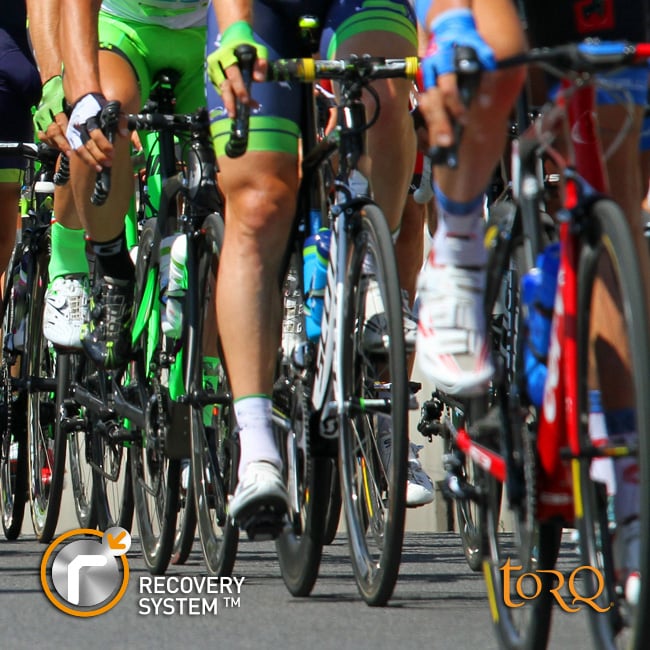
System Introduction
We launched the TORQ Recovery System back in 2012, so that our customers could look at the amount of training they were doing and phase their recovery treatment in accordance to the physical load they were undertaking. Since then, we have refined the system further and, if you do nothing more whilst on this page than watch the 4-minute video at the top of this page, you will have gained a very good idea of what the TORQ Recovery System is all about. Hopefully this will inspire you to explore further into this web page, where we cover the system in much deeper detail.
If you are a runner, you may prefer to watch the video below instead of the one above, however the overall message remains the same irrespective of your endurance sport:

The TORQ Recovery System has been established so that we can recommend specific TORQ products and practices to our customers, depending on the amount of exercise they are doing. If exercise load is light, the use of specific recovery products may not be necessary at all, but as the load increases, more intervention is required. The TORQ Recovery System consists of 4 phases and is cumulative, so essentially the more exercise you are loading your physiological systems with, the more and greater variety of nutrition you will need to consume – and this includes real food (TORQ products are supplements, not dietary replacements). Below, we run through the 4 phases in brief and cover them in more detail further across the other tabs.
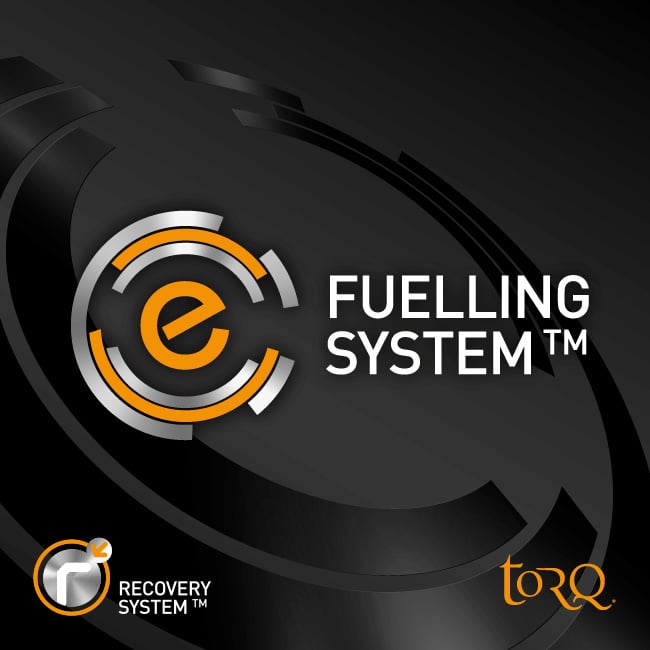
Phase 1 should be your first intervention and simply involves diligently following the TORQ Fuelling System. Fuelling properly in the first place reduces muscle breakdown, maintains hydration and prevents the degradation of muscle and liver glycogen. The benefits of fuelling properly are covered comprehensively in this video.
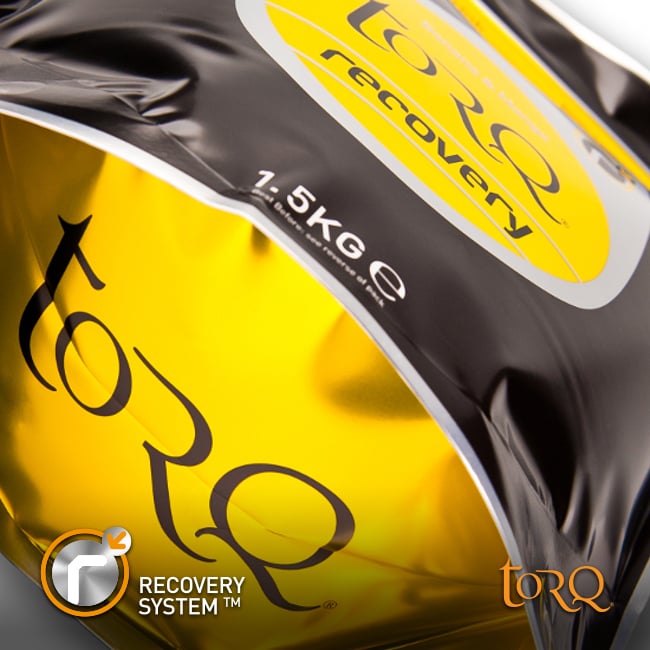
Phase 2 involves the use of TORQ Recovery Drink within 15 minutes of exercise completion to rehydrate the tissues of the body, restock muscle and liver glycogen, repair damaged muscle fibres and recharge cellular energy levels.
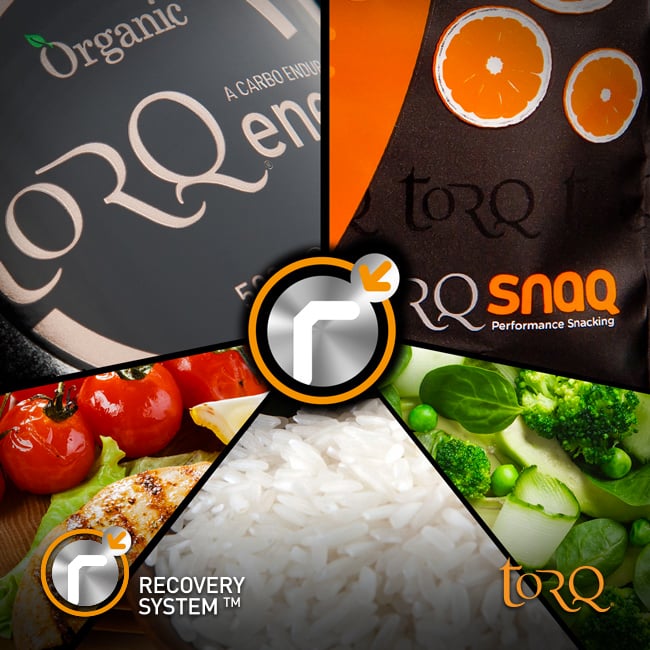
Phase 3 is all about hunting for rich carbohydrate and protein sources within your diet. You should be doing this anyway, but as exercise load increases, your need for high quality nutrients increases. TORQ Energy Organic is a pure unflavoured source of carbohydrate. Dubbed the ‘invisible calorie’, it represents the ideal way to increase the carbohydrate content of regular foods easily and because it has no flavour, you’ll hardly know it’s there. The TORQ SNAQ range has also been developed to assist in supporting Phase 3 of the TORQ Recovery System too.
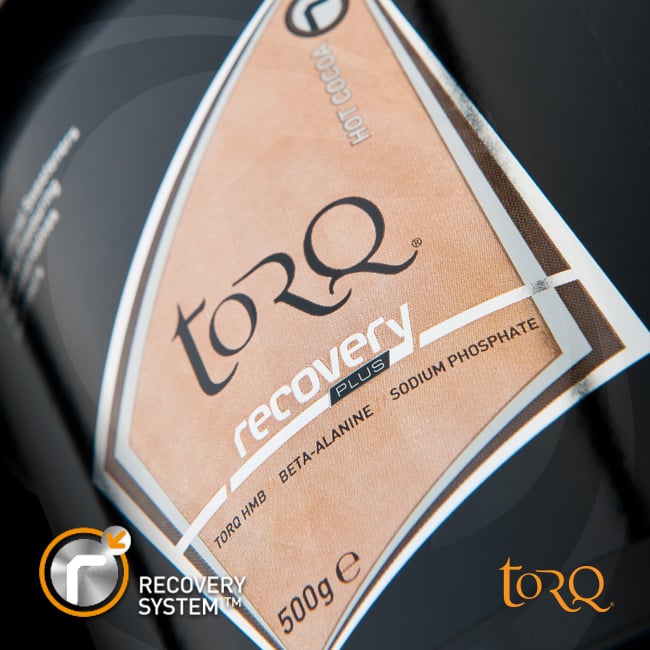
Phase 4 involves the use of our highly advanced TORQ Recovery Plus+ product. Containing Beta-Alanine, HMB and Sodium Phosphate, this product both supports the maintenance of high intensity/high load/quality training and the repair/adaptation processes required to progress. TORQ Recovery Plus+ really is the icing on the cake.
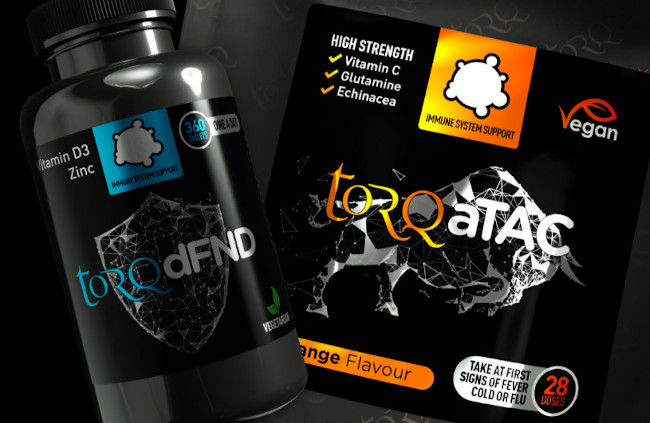
Immune System Support sits outside the phases of the TORQ Recovery System, yet is undeniably intertwined. Robust immune system health is going to be essential if you’re going to be putting the time and effort in required to develop your physiology. TORQ produce two products, TORQ dFND and TORQ aTAC dedicated to immune system support.
From a training perspective though, it’s all about facilitating a higher training load and that’s what the TORQ Recovery System addresses so well. The higher the training load, the greater the adaptation and the greater the adaptation, the stronger you’ll get. In other words, the more training you are able to do, the fitter you will get and the TORQ Recovery System is focused entirely on allowing you to train more often and at a higher quality/output. Having a proper recovery strategy in place ultimately drives fitness forward, so dedicated recovery products shouldn’t simply be viewed as a post race/event treat, they should form a fundamental part of the training process. We cover this topic in a lot more detail a few tabs along under the tab Recovery Explained.
4 R's
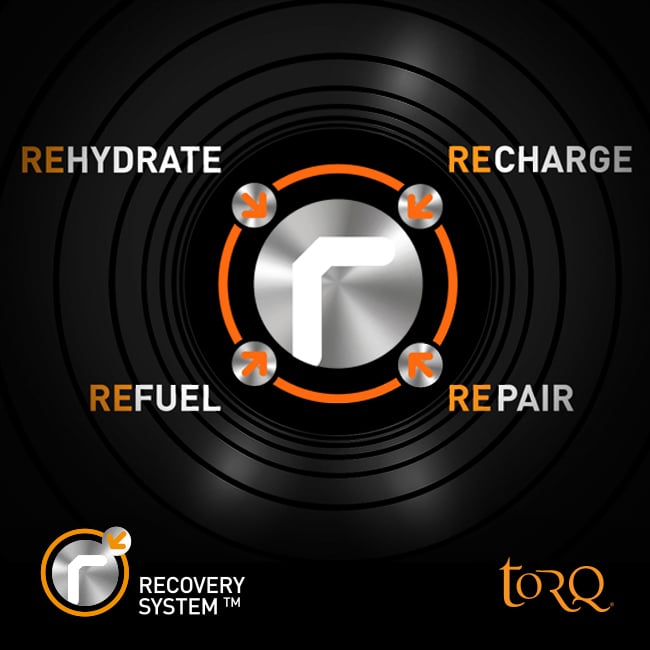
Unique to TORQ, we talk about the 4R approach to recovery. All of these processes are vital in returning the body to a healthy recovered state, primed for physiological adaptation.
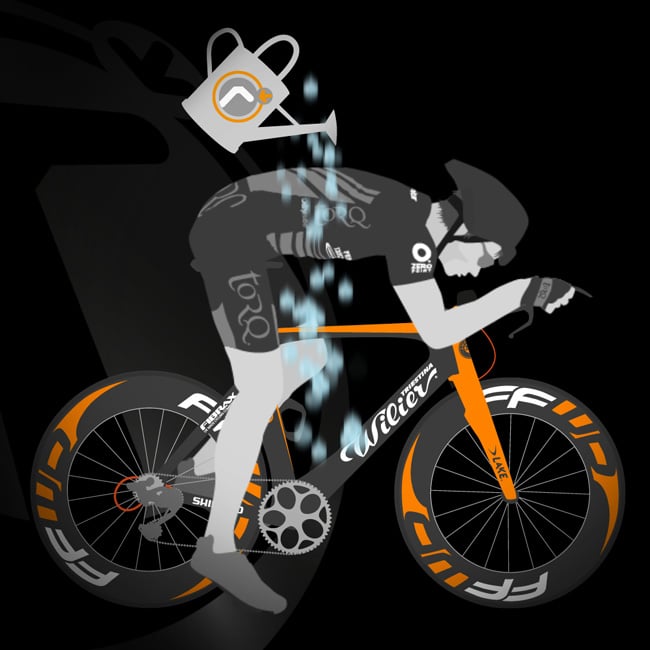
Re-Hydrate: Replenishing lost fluid is fundamental to the recovery process. Dehydration can initially be countered by ensuring that sufficient fluid and electrolytes are taken on board whilst exercising, so following the TORQ Fuelling System diligently will automatically take care of this. In hot/humid conditions, or during high intensity exercise when perspiration rates are high, it can sometimes be impossible to consume sufficient fluid during exercise to replace that lost through sweating, so this needs to be addressed immediately. TORQ Recovery Drink contains a wide variety of valuable nutrients, but in addition, being a drink, it also contains a significant amount of water and sodium (the most important electrolyte). It may also be necessary to consume plain water or other beverages afterwards to continue the hydration process, or even consider our TORQ Hydration drink if the general ambient environmental conditions causes perspiration to continue to occur after exercise has ceased.
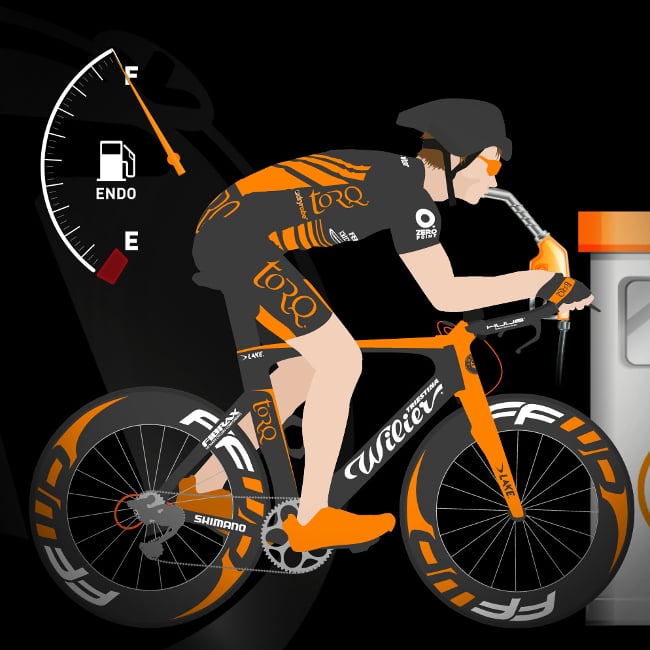
Re-Fuel: Prolonged and/or high intensity exercise will deplete your stored ‘endogenous’ carbohydrate supplies. It’s only possible to store about 500g (2,000 Kcals) of carbohydrate, and without these endogenous stores, physical performance becomes quite pedestrian. High intensity endurance and sprinting modes of exercise are literally impossible to perform without high levels of stored endogenous carbohydrate. A hard training session today can leave you in no fit state to perform tomorrow, unless you consider this concept very carefully. Diligently following the TORQ Fuelling System will provide an alternative external or ‘exogenous’ source of carbohydrate whilst you’re exercising, sparing your endogenous stores. Fuelling properly today will go a long way towards ensuring you perform better tomorrow in the first instance, but, if the training load is high, your endogenous stores will still suffer depletion despite conscientious fuelling. Re-fuelling therefore represents a major role for a recovery product and our TORQ Recovery Drink has been optimised for the job, delivering a much needed carbohydrate supply immediately after exercise cessation. When training load is particularly high, re-fuelling needs to continue long after exercise has finished through the consumption of high quality dietary carbohydrate sources, as well as potentially incorporating TORQ Energy Organic or the TORQ SNAQ range into your regimen. This is all explained under the 4 Phases of the TORQ Recovery System in the next tab.

Re-Pair: High intensity exercise will literally damage muscle fibres and prolonged endurance exercise encourages catabolic processes, whereby vital lean tissue gets broken down and used by the body for fuel. Consuming high quality proteins that contain a wide variety of amino acids (the building blocks of protein) is essential immediately after exercise, because they provide the substrate for muscular repair and the resources to help regenerate enzymes (biological catalysts) and other important physiological components. TORQ Recovery Drink contains 100% fast-acting Whey Protein, because no other protein source comes close to whey from a solubility and bio-availability perspective. TORQ Recovery Drink also contains a significant dose of L-Glutamine too. Although it’s the most abundant amino acid in the body, muscle and lean tissue is broken down immediately after exercise in an act of ‘Glutamine scavenging’ to fuel the over-worked organs of the body and this can be nipped in the bud by consuming Glutamine it in its raw form. Glutamine consumption interestingly therefore indirectly prevents muscle damage and helps service the immune system too. TORQ Recovery Drink also contains a comprehensive vitamin and mineral mix to aid the repair and replenishment process.
Finally, during very high load training, muscle damage/degradation starts to become more and more of a problem and this is why we produced our TORQ Recovery Plus+ product. The Beta-Alanine contained within this formulation helps to drive high intensity exercise, whilst the HMB acts like a super-protein with incredible natural anabolic, muscle-building and regenerative properties. To learn more about Glutamine, Beta-Alanine and HMB, take a look at the TORQ Recovery Plus+ product page or visit the TORQ BULQ menu page and select the appropriate nutrient.
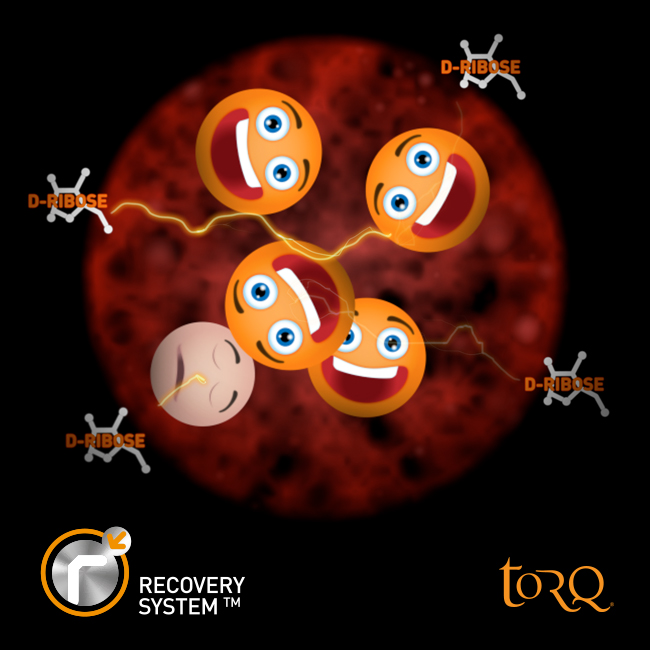
Re-Charge: It’s the 4th ‘R’ that really is unique to TORQ and our Recovery System that you’re going to struggle to find anywhere else. TORQ was established in 1999 and the use of D-Ribose as an ingredient has almost become synonymous with the brand. Scientific evidence for D-Ribose supplementation enhancing sporting performance doesn’t exist, but it’s ability to return cellular energy levels to normal quickly is indisputable (340-430% quicker than without supplementation in fact). There is a research-recommended dose of Ribose in every serving of TORQ Recovery Drink.
Every cell in your body contains ATP (adinosine triphosphate), an energy-rich compound that provides virtually all the energy needed to function on a second-by-second basis. When ATP is broken down into ADP + Pi (adinosine diphosphate + inorganic phosphate) energy is released and this is used to power all our bodily functions. Naturally then, it is the breakdown of ATP within the cells of the working muscles that provides the energy for exercise. Without it you wouldn’t be going anywhere! It is through the metabolism of carbohydrate, fat and protein that ADP + Pi is reformed to make ATP. This ATP is then available to be used for muscular contraction. As the muscle uses it, once again it will break down to ADP + Pi and so it goes on.
When exercising, this cycle rapidly and continually takes place in order to satisfy the substantial turnover of energy required. Research has shown that after maximal high load exercise, the pools of ATP and ADP + Pi in skeletal muscle cells are reduced by as much as 20-28 percent. The mechanisms behind this are rather complex and involve the loss of a compound called AMP (adinosine monophosphate), however, the net effect is that the overall pools of ATP and ADP + Pi within each cell are reduced, which seriously limits their energy potential. It doesn’t matter how much carbohydrate you ram into your body, if these nucleotide levels are low, you’re not going to have the raw materials available to produce power effectively. To further compound the problem, once AMP has left the cell, there’s no getting it back and so ATP and ADP + Pi levels will remain low, perhaps sinking further if another high intensity bout of exercise is experienced.
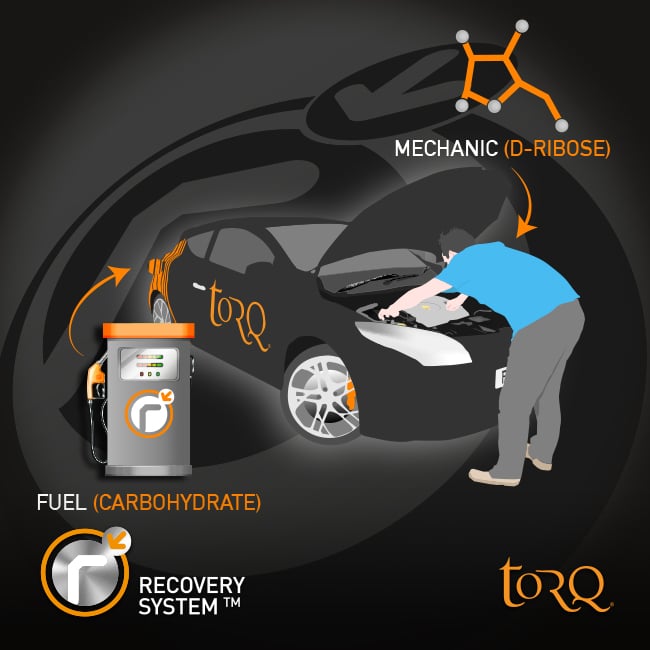
So that’s the science, but in simplistic terms, think of a car being tuned by a mechanic as an analogy. Consider the fuel tank as your endogenous carbohydrate store (this is the fuel that drives the engine/your muscles) and separate this from the engine itself. Imagine an engine with a couple of spark plug leads removed so that it’s running on 50% power. It doesn’t matter how full the fuel tank is, if the engine isn’t tuned properly, you won’t get the optimal performance out of the vehicle. So think of the mechanic tuning the engine in the picture above as the role Ribose plays within your muscle cells – it allows the fuel you have in your tank to have maximum effect. Conversely, imagine a highly tuned car with no fuel in the tank – it wouldn’t matter how tuned the engine is, without fuel it would be going nowhere. This demonstrates the critical interplay between cellular energy charge/potential and the fuel required to drive performance.
In summary, the focus of the TORQ Recovery System is to ensure that everything is replenished, so that each time you train, you’re a fully fuelled vehicle with a highly tuned engine.
4 Phases
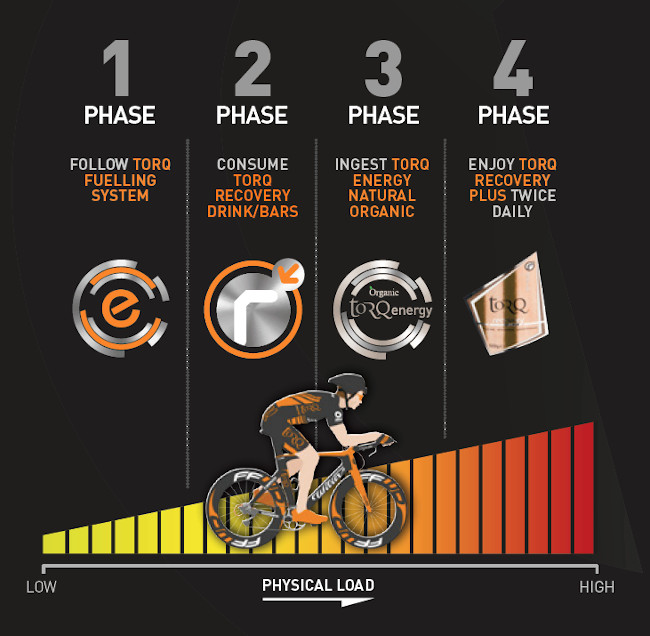
The 4R’s explain why you need to recover properly, and have provided you with a summary of how our products fit in to that process. Now we will discuss the TORQ Recovery System in detail, so that you are 100% clear on what recovery intervention to use relative to the amount of exercise you’re doing. You need to think about what is necessary from a recovery perspective. Why waste your money on technical products like TORQ if you’re not doing enough to benefit from them? Our Performance Nutrition range works incredibly well and the more you do, the better it will function for you, but give some careful consideration to the amount of training you’re doing.
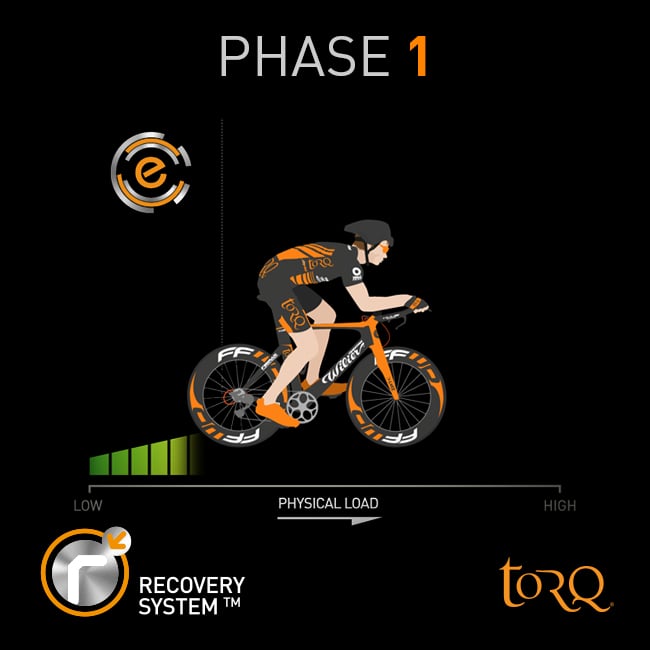
PHASE 1 // Follow the TORQ Fuelling System: Fundamental to the recovery process is ensuring that you fuel properly and we have designed the TORQ Fuelling System to do just that. If you haven’t done so already, take the time to read about it HERE. On the Fuelling System page, we don’t only explain how fuelling aids performance, but we also demonstrate through animation how taking on board exogenous carbohydrate sources, through the consumption of energy drinks, gels, bars and chews whilst exercising, spares your internal endogenous stores of carbohydrate. If you look after your internal stores of carbohydrate, you leave less work for your recovery products to do, so it could follow that as long as you fuel properly in the first place and make an effort to consume rich sources of carbohydrate and protein from your regular diet after exercise, you may not need to use a recovery product at all!
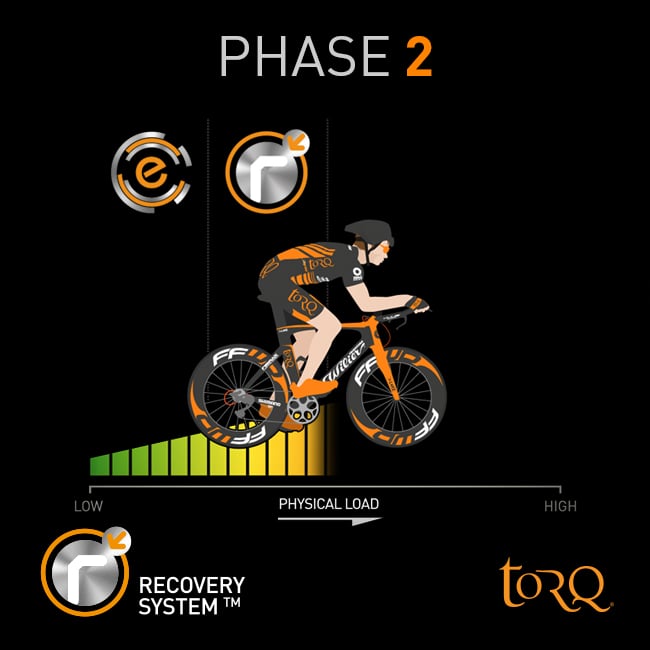
PHASE 2 // Consume TORQ Recovery Drink within 15 minutes of exercise completion: There are 2 ways you can look at Phase 2. If you haven’t followed Phase 1 and fuelled properly for one reason or another and the exercise session has been ‘significant’, you will benefit greatly from following Phase 2, because this is all about putting back what you’ve lost. Your endogenous stores of carbohydrate will have taken a big hit and you will need to replenish them. The intended role of Phase 2 is, however, is to combine competent fuelling during exercise with the use of TORQ Recovery Drink immediately afterwards. Combining Phase 1 with Phase 2 as a cumulative process will provide a much more comprehensive level of recovery than following either Phase 1 or 2 on their own.
The amount of TORQ Recovery Drink to consume is dependent on bodyweight, so visit the specific product page for further information. The primary role of TORQ’s Recovery Drink is to replenish endogenous carbohydrate stores and provide protein, vitamins and minerals for muscular repair and resource replenishment. In addition, it will rehydrate the tissues of the body, provide L-Glutamine for muscular protection and D-Ribose for restoration of cellular energy levels.
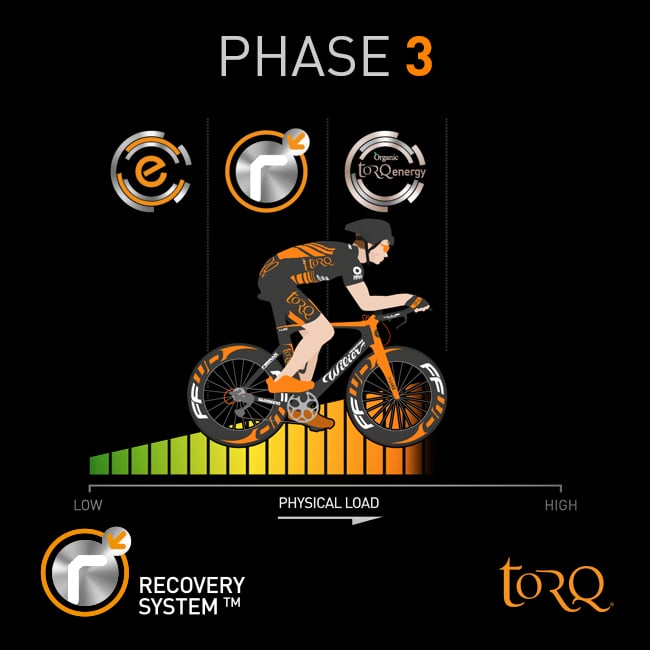
PHASE 3 // Increased focus on general diet and use of TORQ Energy Organic and the TORQ SNAQ range: As exercise load increases, your recovery protocol should start to expand beyond the nutrition taken on board during exercise and immediately afterwards. The human body can only process up to 90 grams of carbohydrate per hour during exercise and even that is impossible for many products. Immediately after exercise, during Phase 2, we suggest consuming a gram of carbohydrate per Kg of bodyweight and 1/4 gram of protein per Kg of bodyweight via a recovery drink and this leaves a large span of time between these interventions and your next exercise session. It’s during this time, that more work can be done if exercise load has increased to the point where even diligent fuelling and consumption of recovery products still isn’t enough!
First of all, you need to look at your general diet again. Can you eat more? Can you make some better dietary choices so that you are consuming more high quality rich carbohydrate and protein sources? Sometimes, when training load is particularly high, it’s literally impossible to consume enough calories to replace those lost through exercise and this is where TORQ Energy Organic is a saviour. Dubbed ‘The Invisible Calorie’ – TORQ Energy Organic is precisely that – it’s a 100% complex carbohydrate source which has no sweetness, yet has the density of sugar. It can be added to sweet or savoury dishes to boost the carbohydrate content significantly without having any impact on flavour. It can even be added to tea or coffee and is Soil Association Certified Organic.
The TORQ SNAQ range of products includes handy dehydrated meals and breakfasts designed to support the recovery process and also assist in peaking for events. The rationale behind this range of enriched foods has been to develop a product range specifically focused at supporting athletes and physically active people to assist in the vital recovery and adaptation processes. These products aren’t intended to replace regular food, but they represent useful tools for the job nonetheless.
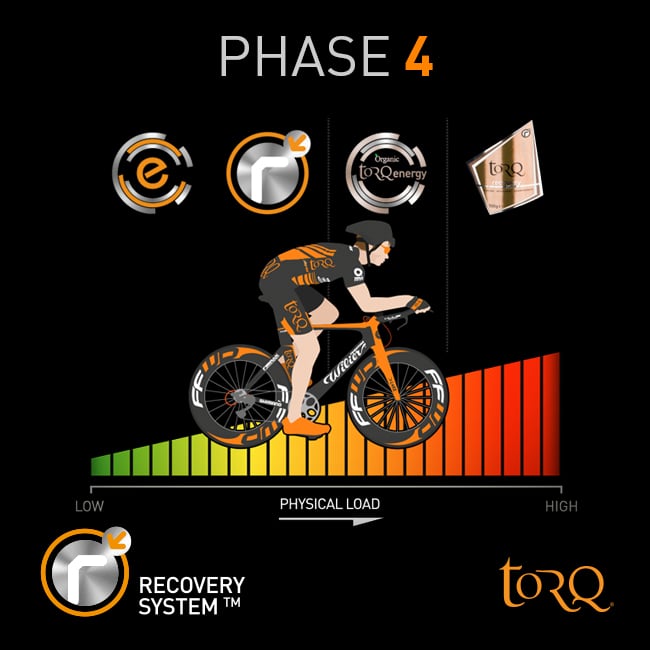
PHASE 4 // Consume TORQ Recovery Plus+ twice per day, every day: This phase of the TORQ Recovery System is all about ‘putting the icing on the cake’ so to speak and we’ve formulated the highly advanced TORQ Recovery Plus+ Hot Cocoa drink to facilitate both a higher training load and exemplary recovery and adaptation. Please take the time to read the ‘Recovery Explained’ section a couple of tabs along so that you can fully understand the interplay between the training stimulus, recovery from the stimulus and ultimately ‘adaptation’ as a result of receiving and reacting to the stimulus.
TORQ Recovery Plus contains 3 key potent ingredients: HMB (Beta-Hydroxy-Methylbeutyrate), Beta-Alanine and Sodium Phosphate. HMB has amazing nitrogen-retention qualities, which makes it both naturally anabolic (body building) and anti-catabolic (prevents muscle breakdown). Beta-Alanine is a branched chain amino acid that helps to increase lactic acid buffering (removal), which results in increased anaerobic power, as well as aiding recovery between high intensity racing/training bouts. Sodium Phosphate complements Beta-Alanine by empowering the aerobic system to round off a truly comprehensive system.
Ultimately, TORQ Recovery Plus+ doesn’t only aid recovery during periods of high training stress, it contains key ingredients to boost performance as well. As a brief guide to usage of this product, TORQ Recovery Plus+ will provide benefits if taken continually during any high load training period, because of its HMB content, but the Beta-Alanine and Sodium Phosphate offer most potential during high intensity interval training and racing. Therefore, TORQ Recovery Plus+ is ideal for use throughout the competitive season, or in the lead up to (and including) a training camp or cycling holiday, where exercise intensity is going to be mixed (intense and prolonged).
It is the interplay between Beta-Alanine and HMB in TORQ Recovery Plus+ that is the most interesting and exciting. Beta-Alanine essentially creates a greater anaerobic training stimulus, by allowing you to maintain higher top-end power outputs for any given interval duration. This causes muscular damage (the section below explains how this is actually a good thing) and what HMB is particularly good at doing is knitting damaged muscle fibres back together again. The two nutrients work harmoniously together resulting in a greater training stimulus and stronger adaptation.
There are other beneficial uses for this product as a stand-alone training aid for some sprint-based disciplines, which you can read about on the TORQ Recovery Plus+ product page. Within the context of the TORQ Recovery System though, this product should always be used as part of the system, not on its own.
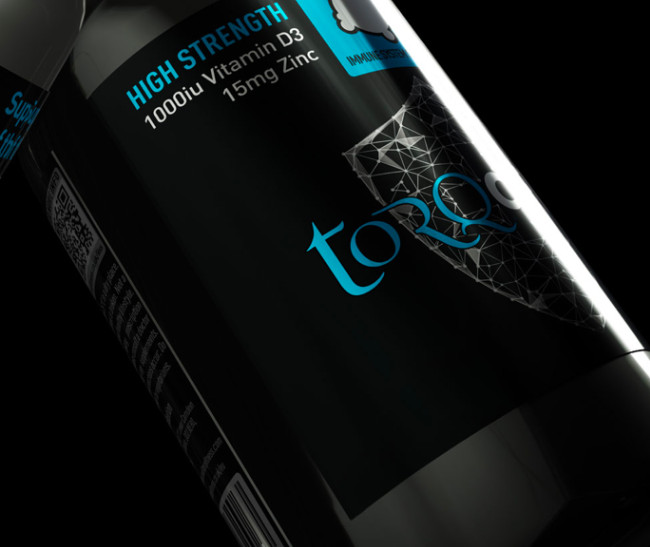
IMMUNE SYSTEM SUPPORT // Consume TORQ dFND daily and TORQ aTAC during higher load training weeks or when you feel vulnerable to infection. Pushing your body to encourage adaptation in itself will put your immune system under stress and at the same time, the TORQ Recovery System by its very nature will look after your immune system. In our extremely well researched Immune System Support Resources we talk about the protective role that fuelling with carbohydrate plays and ensuring that carbohydrate, protein and glutamine are consumed immediately after exercise. We also talk about human behaviour and ensuring that you avoid social contact for 4 hours after heavy exercise to reduce the chances of picking up an infection.
If you’re following the TORQ Recovery System, eating healthily and listening to your body, your immune system is likely to be in a very good place, but there’s no escaping the fact that at times you will overstep the mark and that’s what TORQ’s Immune System Support products have been designed to protect against.
TORQ dFND is a one-a-day tablet containing a potent concentration of Vitamin D3 and Zinc to support the normal functioning of the immune system. Each TORQ dFND tablet contains 1000iu Vitamin D3 and 15.6mg Zinc at a potent 500% and 156% of daily reference values respectively. Both of these nutrients have been found to be deficient in the human body with Vitamin D being at lower levels in the winter months in particular and Zinc deficiency especially common in those following a vegetarian or vegan diet. There is good reason to take this supplement all year round especially if you spend extensive periods of time indoors or restrict the amount of sunshine to your skin during the summer months.
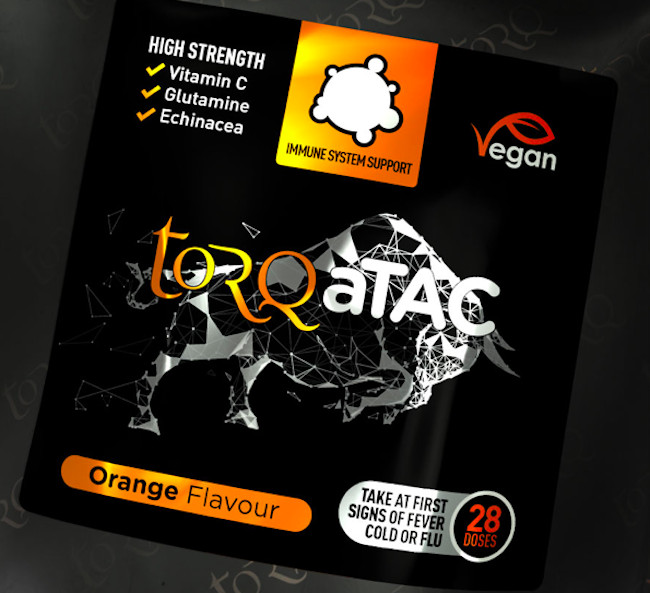
TORQ aTAC contains high strength Vitamin C (1,000mg), Glutamine (1,000mg) and Echinacea (500mg) and can be taken daily during periods of extremely high training stress or when feeling particularly vulnerable to infection – perhaps in the winter time whilst everyone’s coughing around you. One dose per day is adequate in the context of the TORQ Recovery System and TORQ aTAC shouldn’t be taken continually, just occasionally. It can be taken under a mega-dosing protocol if you actually get sick too and it will vastly improve your recovery time and reduce the severity of symptoms. To learn more, please click HERE.
The Products
All of the products used within the TORQ Recovery System have been discussed in detail up to this point, but here’s a summary to confirm:

TORQ Recovery Drink: To be used in Phase 2 of the TORQ Recovery System onwards. For further information on this product, click HERE.
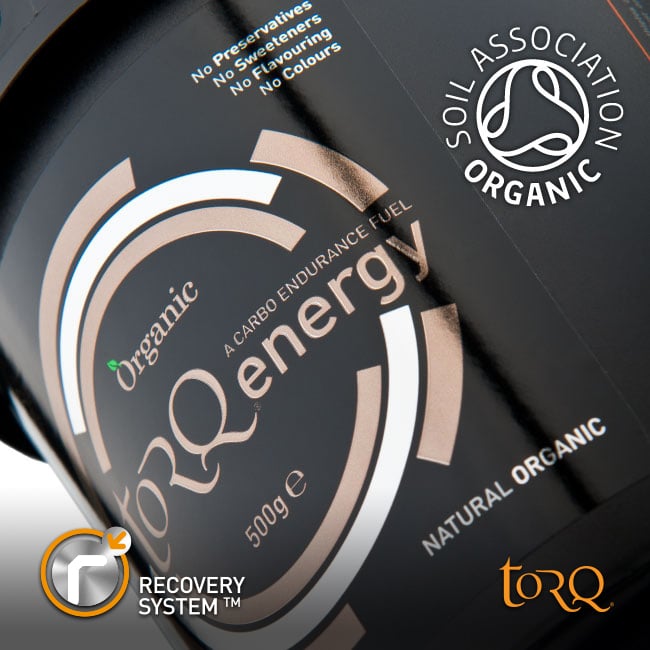
TORQ Energy Organic: To be used in Phase 3 of the TORQ Recovery System onwards.For further information on this product, click HERE.
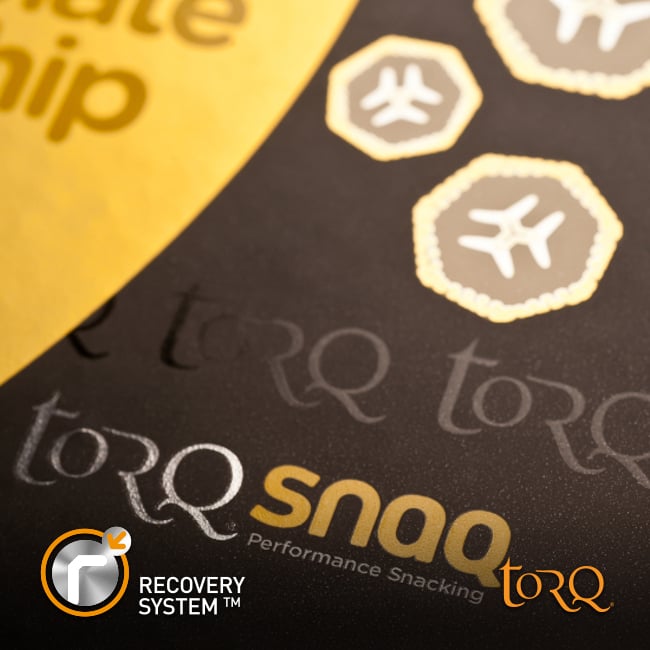
TORQ SNAQ: To be used in Phase 3 of the TORQ Recovery System onwards.For further information on this product, click HERE.

TORQ Recovery Plus: To be used in Phase 4 of the TORQ Recovery System only. For further information on this product, click HERE.
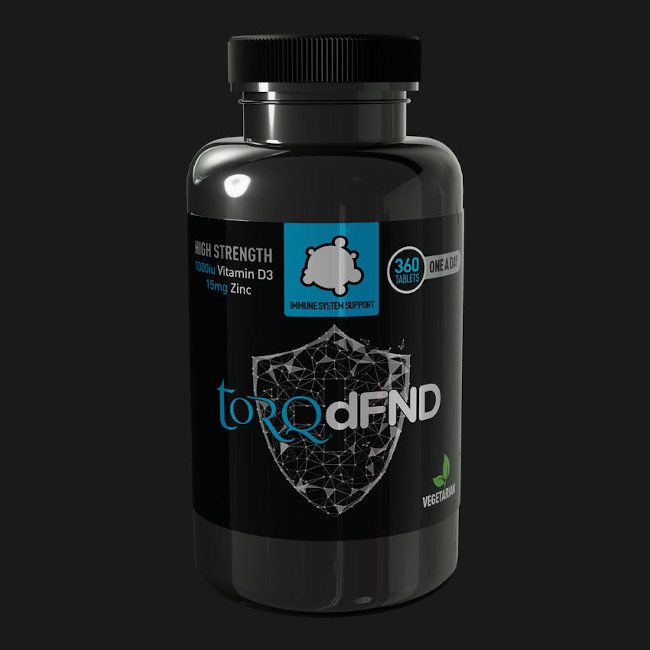
TORQ dFND: One tablet to be taken daily. For further information on this product, click HERE.
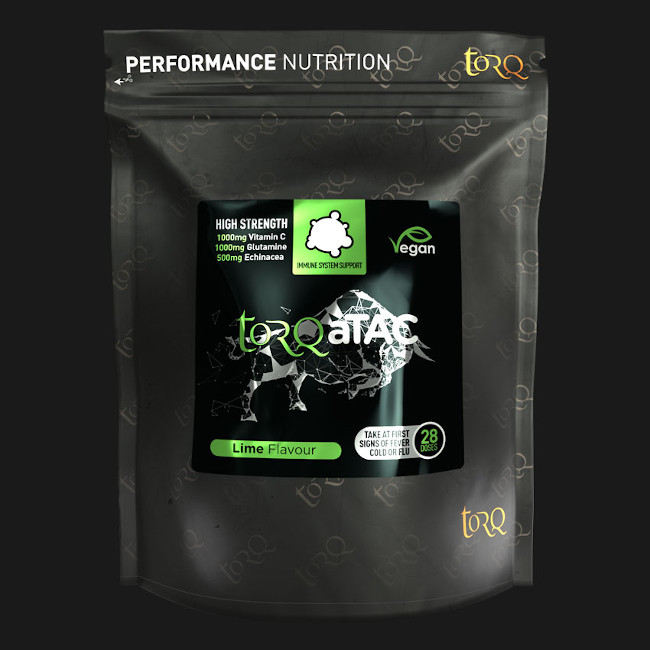
TORQ aTAC: One dose to be taken daily at times of very high training stress or when feeling vulnerable to infection. For further information on this product, click HERE.
Recovery Explained
To understand the recovery process properly, first of all you need to consider the training process. Once you understand this, it will be clear how attention to your diet, in combination with following the TORQ Recovery System, will help you to achieve your highest level of performance.
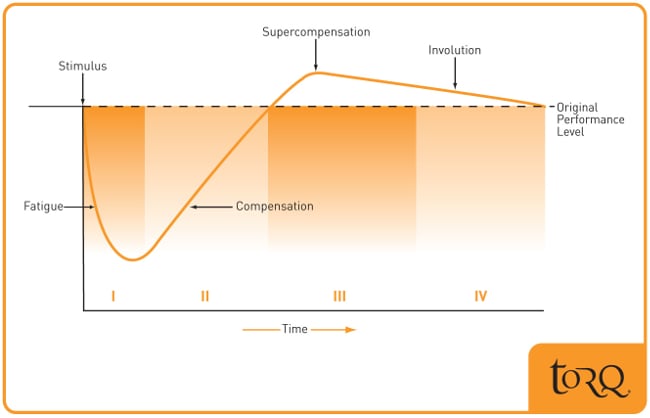
Figure 1: Diagram adapted from Bompa ‘Periodization: Theory and Methodology of Training.’ Human Kinetics (1999).
This diagram above explains the training process beautifully. If you consider the vertical axis to be your ‘energy level’ and the horizontal axis to be ‘time’, Phase I shows the fatigue induced by a training session. Phase II demonstrates the body recovering and Phase III indicates an over-energised state, where the body has actually over-recovered (stronger than it was before the training session). Phase IV shows a regression of form as the over-energising wears off.
Each phase is of importance, but it’s Phase III that we’re obviously interested in – the getting stronger part. How does this happen? Clearly and simply, this is how all biological systems respond to a stimulus. We are not machines, so we don’t perform the same amount of consistent work, day in day out and get parts changed when they wear out or break. We are adaptive organisms, which means that when we’re put through hardship, we become weaker for a short time (Phase I). The shock of the stimulus causes our body to throw every resource it has at the situation (including important components of our diet) to facilitate repair and re-energising (Phase II). It’s little wonder then that we get Supercompensation (Phase III) when you consider how over-resourced we become.
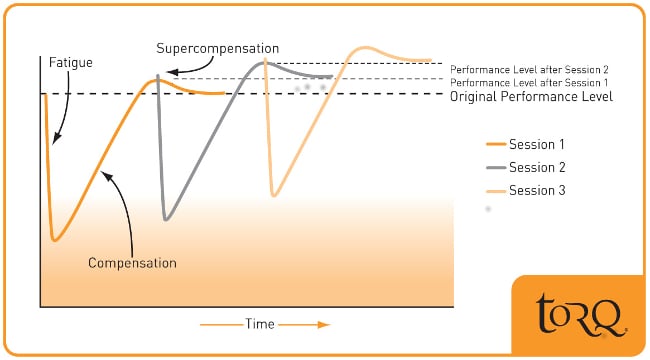
Figure 2. Adaptation Strategy ‘A’.
The diagram above shows what happens when you throw a few well-timed training sessions together.
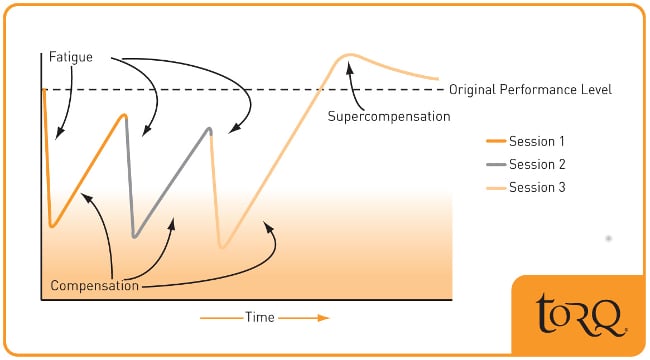
Figure 3. Adaptation Strategy ‘B’.
Or you could string a number of training sessions together, deliberately allowing inadequate recovery, thus producing a deep trough of fatigue and a subsequent peak in form for a big event.
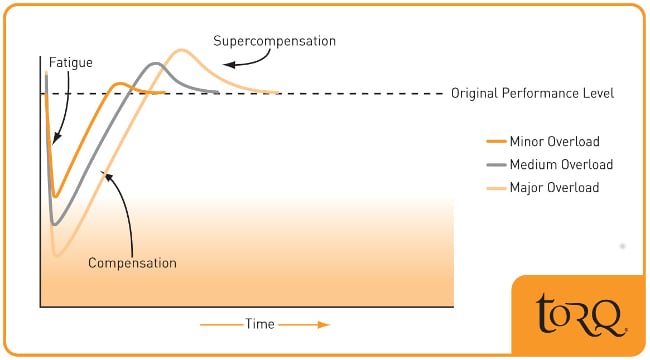
As much as we’d like to separate the concepts of fuelling and recovery and discuss them independently, it’s impossible, because they are unquestionably linked and this is why Phase 1 of the TORQ Recovery System is the TORQ Fuelling System. It goes without saying that a well recovered athlete is going to be in a better physiological state prior to an important training session than someone who is tired and under-fuelled. The diagram above demonstrates how a well-prepared athlete is able to generate a bigger training stimulus and therefore gain greater fitness benefit from a training session. Also, consider how an effective fuelling strategy during exercise could prolong and intensify the workout.
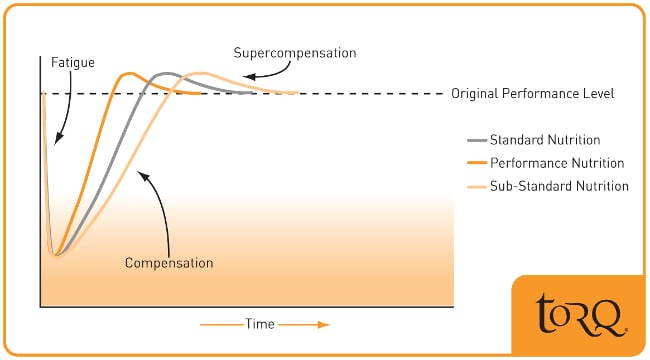
This next diagram shows how much quicker an athlete will recover if he/she uses an effective recovery strategy post exercise – the TORQ Recovery System perhaps? If you combine the key concepts in both of the last two diagrams, it becomes clear that a performance-fuelled athlete will be able to both train harder and recover quicker. Your best performances really are as simple as that!
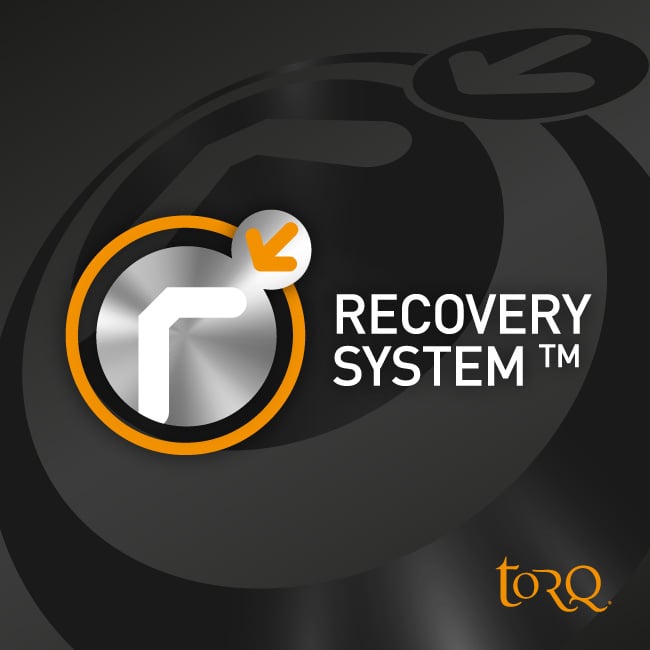
If you have any questions at all about the TORQ Recovery System or any of the products/concepts discussed on this page, please don’t hesitate in contacting us on enquiries@torqfitness.co.uk or by phone on 0344 332 0852.
Research References
- Beelen M, Burke LM, Gibala MJ, Van Loon L JC (2010)
Nutritional strategies to promote post exercise recovery. Int J Sport Nutr Exerc Metab Dec 20(6):515-32. - Burke LM, Collier GR, Beasley SK, Davis PG, Fricker PA, Heeley P and Hargreaves M (1995)
Effect of coigestion of fat and protein with carbohydrate feedings on muscle glycogen storage. Journal Applied Physiology, 76(6) 2187-2192. - Fallowfield JL, Williams C, Singh R. (1995)
The influence of ingesting a carbohydrate-electrolyte beverage during 4 hours of recovery on subsequent endurance capacity. Int J Sport Nutr 1995; 5: 285-99. - Ivy Jl, Katz AL, Cutler Cl, Sherman WM, Coyle EF (1988)
Muscle glycogen synthesis after exercise: effect of time of carbohydrate ingestion. Journal Applied Physiology. Apr:64(4)1480-5. - Wallis GA, Hulston CJ, Mann CH, Roper HP, Tipton KD, Jeukendrup AE.
(2008) Postexercise muscle glycogen synthesis with combined glucose and fructose ingestion. Med Sci Sports Exerc. Oct;40(10):1789-94. - Décombaz J, Jentjens R, Ith M, Scheurer E, Buehler T, Jeukendrup A, Boesch C.
(2011) Fructose and galactose enhance postexercise human liver glycogen synthesis. Med Sci Sports Exerc. 2011 Oct;43(10):1964-71. - Betts JA, Williams C. (2010)
Short-Term recovery from prolonged exercise. Sports Medicine. 40(11)941-959. - Beelen M, Burke LM, Gibala MJ, Van Loon LJC. (2010)
Nutritional strategies to promote post exercise recovery. Journal of Physical Activity and Health. - Jentjens, R.L., van Loon, L.J., Mann, C.H., Wagenmakers, A.J.,& Jeukendrup, A.E. (2001).
Addition of protein and amino acids to carbohydrates does not enhance postexercise muscle glycogen synthesis. Journal of Applied Physiology), 91(2), 839–846. - van Loon, L.J., Saris, W.H., Kruijshoop, M., & Wagenmakers, A.J. (2000b).
Maximizing postexercise muscle glycogen synthesis: Carbohydrate supplementation and the application of amino acid or protein hydrolysate mixtures. The American Journal of Clinical Nutrition, 72(1), 106–111. - Gibala, M.J. (2007).
Protein metabolism and endurance exercise. Sports Medicine (Auckland, N.Z.), 37(4–5), 337–340. - Howarth, K.R., Moreau, N.A., Phillips, S.M., & Gibala, M.J.(2009).
Coingestion of protein with carbohydrate during recovery from endurance exercise stimulates skeletal muscle protein synthesis in humans. Journal of Applied Physiology (Bethesda, Md.), 106(4), 1394–1402. - Tang, J.E., & Phillips, S.M. (2009).
Maximizing muscle protein anabolism: The role of protein quality. Current Opinion in Clinical Nutrition and Metabolic Care, 12(1), 66–71. - Dangin, M., Guillet, C., Garcia-Rodenas, C., Gachon, P., Bouteloup- Demange, C., Reiffers-Magnani, K., . . . Beaufrère,B. (2003).
The rate of protein digestion affects protein gain differently during aging in humans. The Journal of Physiology, 549(Pt. 2), 635–644. - Zawadzki, K.M.,B.B. Yaspelkis III, and J.L. Ivy. (1992).
Carbohydrate-protein complex increased the rate of muscle glycogen storage after exercise. J Appl Physiol 72:1854-59. - Burke, E.R. PhD (1999).
D-Ribose, what you need to know. Avery Publishing Group. - Burke, E.R. PhD (2002).
Serious Cycling. Human Kinetics. Pages 167-169 (Ribose), 171-172 (L-Glutamine), 173-174 (HMB). - Paswater, R.A. PhD and Fuller, J. PhD (1997).
Building Muscle Mass, Performance And Health With HMB. Keats Publishing. - Williams, M.H. PhD (1998).
The Ergogenics Edge. Human Kinetics. - Wilmore, J.H. and Costill, D.L. (1999).
Physiology of Sport and Exercise. Human Kinetics. - Bompa, T.O. (1999).
Periodization: Theory and Methodology of Training. Human Kinetics. - Baguet A, Reyngoudt H, Pottier A, Everaert I, Callens S, Achten E, Derave W. (2009)
Carnosine loading and washout in human skeletal muscles. J Appl Physiol 106:837–842. - Baguet A, Bourgois J, Vanhee L, Achten E, Derave W (2010a)
Important role of muscle carnosine in rowing performance.J Appl Physiol 109:1096–1101. - Derave W, Ozdemir MS, Harris RC, Pottier A, Reyngoudt H, Koppo K, Wise JA, Achten E (2007)
B-alanine supplementation augments muscle carnosine content and attenuates fatigue during repeated isokinetic contraction bouts in trained sprinters. J Appl Physiol 103:1736–1743. - Harris RC, Tallon MJ, Dunnett M, Boobis LH, Coakley J, Kim HJ, Fallowfield JL, Hill CA, Sale C, Wise JA (2006)
The absorption of orally supplied beta-alanine and its effect on muscle carnosine synthesis in human vastus lateralis. Amino Acids 30:279–289. - Hobson RM, Saunders B, Ball G, Harris RC, Sale C (2012)
Effects of beta alanine supplementation on exercise performance: A Meta Anaylsis. Amino Acids (2012) 43:25–37. - Hills CA, Harris RC, Kim HJ, Harris BD, Sale C, Boobis LH, Kim CK, Wise JA. (2006)
Influence of B-alanine supplementation on skeletal muscle carnosine concentrations and high intensity cycling capacity. Amino Acids 32:225-233. - Van Thienen R, Van Proeyen K, Vanden Eynde B, Puype J, Lefere T, Hespel P. (2009)
Alanine Improves Sprint Performance in Endurance Cycling. Med. Sci. Sports Exerc., Vol. 41, No. 4, pp. 898–903. - Cade R, Conte M, Zauner C, Mars D, Peterson J, Lunne D, Hommen N, Packer D. (1984)
Effects of phosphate loading on 2,3 diphosphoglycerate and maximal oxygen uptake. Med Sci Sports Exerc, 16:263-8. - Kreider RB, Miller GW, Williams MH, Somma CT, Nasser TA. (1990)
Effects of phosphate loading on oxygen uptake, ventilatory anaerobic threshold, and run performance. Med Sci Sports Exerc, 22(2):250-6. - Stewart I, McNaughton L, Davies P, Tristram S. (1990)
Phosphate loading and the effects of VO2max in trained cyclists. Res Quart, 61:80-4. - Kreider RB, Miller GW, Schenck D, Cortes CW, Miriel V, Somma CT, Rowland P, Turner C, Hill D. (1992)
Effects of phosphate loading on metabolic and myocardial responses to maximal and endurance exercise. Int J Sport Nutr 2(1):20-47. - Folland JP, Stern R, Brickley G. (2008)
Sodium phosphate loading improves laboratory cycling time-trial performance in trained cyclists. J Sci Med Sport, 11(5):464-8. - Bernardot, D. PhD (2000)
Nutrition for Serious Athletes. Human Kinetics.







